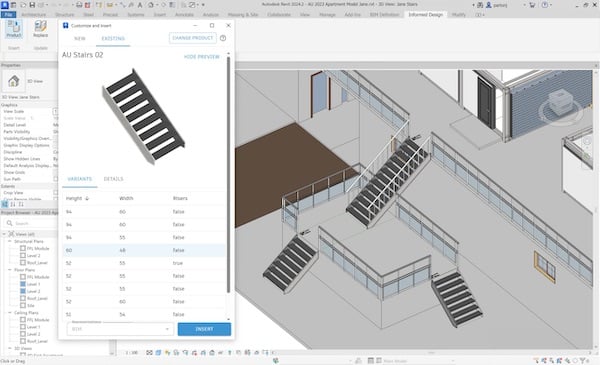
The architecture, engineering, and construction (AEC) industry has historically been slow to adopt change — and for good reason. When you are building roads, bridges, dams, tunnels, and skyscrapers, safety and compliance are paramount. If tried-and-true processes produce the desired results, why fix what isn’t broken and potentially increase risk?
Yet pressure is mounting to do things differently. Worldwide infrastructure needs are exploding, qualified employees are hard to find and harder to keep, and firms are turning away work at record levels. Here are three significant trends we’re tracking:
-
Strong demand for infrastructure repair and investment. The construction industry has a robust pipeline of infrastructure buildouts and spending, and the AEC industry will determine how quickly these projects get off the ground. In the US, the Infrastructure Investment and Jobs Act will allocate $1.2 trillion to improving public infrastructure. Globally, the effects of climate change mean infrastructure will need reinforcement and upgrades to improve resiliency.
-
Need for new infrastructure. Globally, population growth and migration, rapid urbanization, and climate change are all driving strong demand for new infrastructure to feed, house, transport, and provide work and medical facilities to people in new places.
-
Shortage of qualified labor constraints. The full pipeline of projects is good news. The challenge will be for the AEC industry to deliver. The tight labor market and exiting workforce were top challenges noted by more than 82% of respondents in the Deloitte 2022 engineering and construction industry outlook survey. Especially problematic is the ability to find candidates for new digitally oriented roles such as data engineers, data scientists, developers, and cybersecurity.
Digital Transformation and the Promise of Working Better, Faster, and with Fewer Resources
Given unprecedented demand, AEC firms need to do more with less. New technology is a natural place to turn for efficient and effective solutions – going digital promises the ability to work better, faster, with fewer resources, and with better outcomes. According to AEC Advisors, the global AEC market size for all software (not just digital initiatives) was $7 billion in 2020 and is projected to reach $16 billion by 2028, growing at a CAGR of 10.7% (AEC Advisors 2022 State of the Industry report). This spending surge likely means the AEC industry is shifting from old technology and file-based systems to data-driven, digital, and model-based technologies.
The same report found that, on average, CEOs believe within a generation that half of their firm’s value will be attributable to digital transformation. To capture that value, 66% of firms are allocating R&D funding toward going digital right now – investing in everything from component-based design and digital twins to automation and remote inspections.
Nobody Can Afford Another Shiny New Object
Before speeding down this digital transformation path, note that it is about far more than just new technology — if you invest in technology alone, you’ll likely fail. To succeed, you need to not only evaluate and select the appropriate digital solutions but also address how they will affect your people and processes. If a technology changes, so do the people and processes that use and support it. And change is hard. People have routines and habits. Should employees feel excited or scared by the uncertainty? Should they be change advocates or obstacles?
A new digital tool or program also requires learning new things. In some cases, change is stalled by fear of the unknown and not being able to adapt to new methods. All this to say, change enablement is critically important and thankfully, well-documented! It doesn’t matter if you follow eight steps or five, Kotter or Prosci — just that you acknowledge how important change enablement is to the success of your digital transformation. Unless you have the people and process aspects figured out, your new technology may stay a shiny object.
The Why and What of a Successful Digital Transformation
Technology can help AEC firms reimagine their processes so they can be efficient and execute more effectively. But without a thoughtful change enablement plan, your new technologies can become a major headache. Change enablement needs to focus on why this is important to your people and what process will change. Let’s dive deeper:
-
Ensure people understand why change is good for them and the company. Organizations often underestimate the impact going digital can have on the way employees do their job. Your employees have shared values, beliefs, and norms. Many are comfortable with their role and the way they do their jobs, making them resistant to change. Change enablement is a critical piece to removing obstacles and driving adoption. To ensure success, articulate the benefits of the new model and desired behavior for both individual outcomes and firmwide success. If people understand why this is a good thing, they will be more likely to accept and even embrace it.
-
Clearly communicate what is changing. Employees’ next question likely will be “how will this change affect my job?” With your new technology, tool, or technique in hand, it’s time to transform and improve business processes. Business process re-engineering can range from a light to heavy touch, depending on the project. Goal setting helps you define and communicate what you’re trying to achieve. On the process side, assess your current processes, identify those that need to change, and map out how they will change.
Support any new implementation with the necessary training, communication plan, and resources. Monitoring the results is essential. If the new process isn’t working as intended or delivering the desired results, make adjustments. Finally, if employees are at risk of falling back into bad habits, take away the old way of doing business.
Conclusion
Going digital is imperative for AEC firms to compete in today’s dynamic market — but change can be daunting and complex. Don’t fall into the shiny object trap. Instead, look beyond the technology to focus on helping the people and processes that will ultimately ensure positive and sustainable change. AEC firms can reap the rewards of digital transformation — improved employee and operational productivity and increased service offerings — by using change enablement to improve the complete people, process, and technology solution.
Claire Rutkowski
Claire Rutkowski joined Bentley in 2016 from MWH where she served as CIO, responsible for delivering IT strategy, services, and support to 7,000 engineering professionals globally. At Bentley, Claire led the global IT organization, shaping and delivering a technology agenda across Bentley’s business. Claire recently augmented her role to serve as the company’s CIO Champion, leveraging her extensive engineering background to advocate for CxOs at engineering firms and serve as a bridge between Bentley and its engineering accounts. Claire is a PMP and has received numerous awards, most recently the Top 80 CIOs You Should Know in 2020, and one of the Top 10 Most Inspiring Women Leaders in 2022.
View All Articles




Share This Post